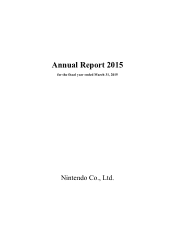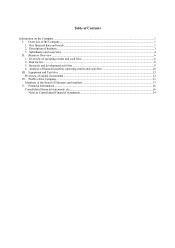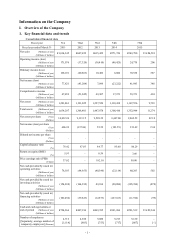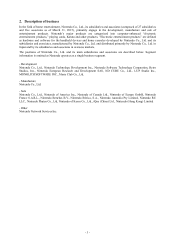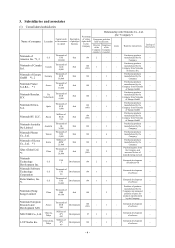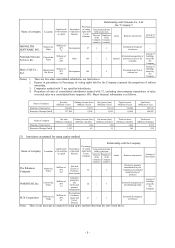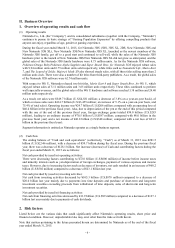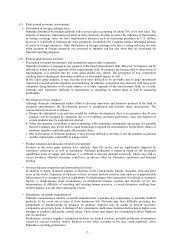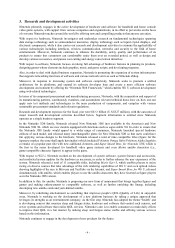Nintendo 2015 Annual Report Download - page 11
Download and view the complete annual report
Please find page 11 of the 2015 Nintendo annual report below. You can navigate through the pages in the report by either clicking on the pages listed below, or by using the keyword search tool below to find specific information within the annual report.- 9 -
3. Research and development activities
Nintendo primarily engages in the active development of hardware and software for handheld and home console
video game systems, with support from various companies and organizations, in its effort to put smiles on the faces
of everyone Nintendo touches around the world by offering new and compelling products that anyone can enjoy.
With respect to hardware, Nintendo investigates and undertakes research on fundamental technologies spanning
data storage technology such as semiconductor memories, display technology such as liquid crystal displays, and
electronic components, while it also carries out research and development activities to examine the applicability of
various technologies including interfaces, wireless communication, networks and security to the field of home
entertainment. Moreover, Nintendo continues to enhance the durability, safety, quality and performance of its
products to ensure that consumers can comfortably enjoy them over an extended period, as well as design and
develop various accessories, and pursue cost-cutting and energy conservation initiatives.
With respect to software, Nintendo focuses on taking full advantage of hardware features in planning its products,
designing games whose elements include graphics, music and game scripts, and developing programs.
Also, in order to deal with digital business expansion, Nintendo is promoting the expansion of system infrastructure
that supports networking functions of software and various network services such as Nintendo eShop.
Moreover, in response to increasing system and software complexity, Nintendo seeks to promote a unified
architecture for its platforms, and expand its software developer base and create a more efficient software
development environment by offering the “Nintendo Web Framework,” which enables Wii U software development
using web-related technologies.
In terms of its component procurement and manufacturing processes, Nintendo, with the cooperation and support of
its manufacturing partners, continuously examines, and accumulates relevant technical know-how on, how one can
apply new test methods and technologies in the mass production of components, and complies with various
sustainable procurement standards and relevant regulations.
Research and development expenses for the fiscal year were ¥63.3 billion (U.S.$527 million), with the outcomes of
major research and development activities described below. Segment information is omitted since Nintendo
operates as a single business segment.
In the Nintendo 3DS family, Nintendo released New Nintendo 3DS (not available in the Americas) and New
Nintendo 3DS XL which are new models equipped with functions such as super-stable 3D. In order to ensure that
the Nintendo 3DS family would appeal to a wider range of consumers, Nintendo launched special hardware
editions of each model, and released many interchangeable plates for New Nintendo 3DS so that users could have
fun applying various designs to the hardware. Nintendo released a total of nine compatible titles (figure for the
Japanese market; the same shall apply hereinafter) which included Pokémon Omega Ruby/Pokémon Alpha Sapphire,
a remake of a popular past title with new additional elements, and Super Smash Bros. for Nintendo 3DS, which is
the first in the series developed for handheld video game systems and even allows amiibo characters (i.e.,
game-compatible character figures) to appear in the game.
With respect to Wii U, Nintendo worked on the development of system software, system features and accessories,
and conducted system updates for the hardware as necessary, in order to further enhance the user experience of the
system. Nintendo released a total of 11 compatible titles, including Mario Kart 8, which enables players to enjoy
racing on diverse courses that take advantage of the rich rendering capabilities of Wii U and even upload videos
showing highlights of the race to Miiverse and YouTube via the Internet, and Super Smash Bros. for Wii U, released
simultaneously with amiibo, which enables players to use the amiibo characters they have fostered as figure players
as in the Nintendo 3DS version.
In addition to this, for amiibo, Nintendo is proposing our new form of amusement that brings together figures and
games and making enhancements to compatible software, as well as further enriching the lineup, including
developing new amiibo cards and yarn-knitted amiibo.
Moreover, by redefining entertainment as something that improves people’s QOL (Quality of Life) in enjoyable
ways, Nintendo is working on the development of a new platform business by taking a unique approach that
leverages its strengths as an entertainment company. As the first step, Nintendo has adopted the theme “health” and
is developing sensors that measure sleep and fatigue status, hardware and software that control such sensors, and
server systems and software that realize QOL services. Nintendo’s aim is to enable consumers to make daily efforts
to improve their QOL in a fun manner by making sleep and fatigue status visible and offering various services
based on this information.
Nintendo continues to engage in the development of new products for the future.

